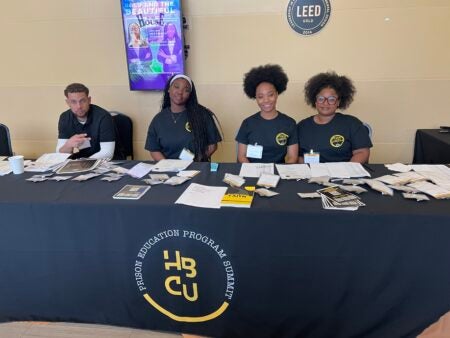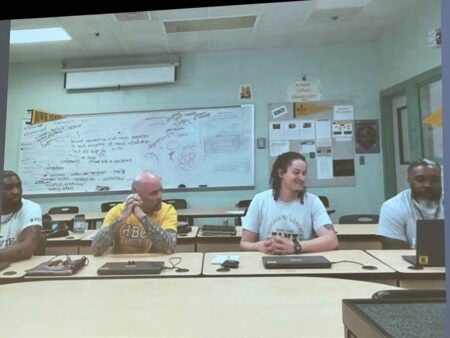Access in Prison at inaugural HBCU Prison Education Summit

Flyer for Bowie State University’s Inaugural HBCU Prison Education Summit. Credit: Bowie State University.
This article is a part of the Inside & Connected series, which shares ideas, interviews, and projects that affect prison-based education, students, and educators.
April 4-6, 2025, marked a historic milestone in the intersection of higher education and criminal justice reform. Bowie State University hosted the nation’s first HBCU Prison Education Summit, convening more than 200 leaders from Historically Black Colleges and Universities (HBCUs), criminal justice advocates, and community organizers. The summit strategized on expanding university courses and degree programs available to people who are incarcerated, as well as building a prison-to-HBCU pipeline. Stacy Burnett from JSTOR Access in Prison attended this event and shares her insights here.
Empowering through education
Bowie State University stands as Maryland’s sole HBCU, offering a four-year degree program to individuals who are incarcerated, providing a Bachelor of Science in Sociology and an optional Certificate in Entrepreneurship. This initiative underscores the university’s commitment to empowering marginalized communities through education. Dr. Charles Adams, chair of the Criminal Justice Department and executive director of the Prison Education Program at Bowie State, emphasized the necessity of such programs in facilitating the transition from mass incarceration to successful reintegration.
HBCUs have long been champions of access and equity in education, and extending that legacy to learners who are incarcerated represents a critical step forward in repairing historic and systemic barriers to opportunity.

Prison Education Program Summit tabling at the conference. Credit: Stacy Burnett.
JSTOR shares innovative technology integration
A standout feature of the summit was the inclusion of people incarcerated at Jessup Correctional Facility participating via secure video connections. This was made possible through Orijin’s tablet technology, which enables students to access educational content and communicate securely with instructors and program staff. The presence of students currently incarcerated participating live at the summit, even virtually, was a powerful act of inclusion—and a real-world example of how technology can improve access to education.
Technology integration emerged as a major theme of the event. The JSTOR Access in Prison/Orijin/IT specialist panel emphasized how secure digital platforms can dramatically expand access to educational materials, while also respecting the security requirements of correctional settings. JSTOR’s Access in Prison initiative, now reaching more than 1,500 facilities globally, was highlighted as a key model for providing curated, scholarly resources in an offline or low-bandwidth environment.
The panelists noted that digital equity inside correctional facilities is not simply about offering “better” education—it is directly linked to post-release success. Graduates who are familiar with using online research tools, completing coursework digitally, and communicating professionally online are better prepared to reenter an increasingly technology-driven workforce.

Students inside participating live at the summit. Credit: Stacy Burnett.
Navigating challenges: policy and funding risks
While the summit celebrated progress, it also tackled the persistent challenges colleges face when operating prison education programs. Sheila Meiman, a nationally recognized expert in prison education and advisor to NASFAA (National Association of Student Financial Aid Administrators), brought critical attention to the operational risks colleges take on under the current regulations.
Meiman outlined how events beyond a college’s control—such as prison lockdowns, which can last days or even weeks—interrupt educational continuity. She referenced the high-profile prolonged lockdown in New York State prisons that forced program pauses, creating significant financial risks for institutions. Under current Department of Education regulations, if a student cannot complete a term, colleges might be required to return portions of Pell Grant funds, even though the disruption was due to facility security measures. This, in turn, could result in incarcerated students being saddled with unexpected tuition bills—debt they have no ability to repay while incarcerated.
Meiman’s remarks underscored that while providing higher education in prisons is deeply mission-driven work, it also demands structural reforms to federal rules and greater protections for institutions serving justice-impacted learners.

Bowie State University mascot. Credit: Stacy Burnett.
A national moment for transformation
The summit’s conversations echoed broader national research on technology and equity in carceral education. Reports from Ithaka S+R have highlighted how even modest access to technology inside prisons can make an enormous difference, both in academic achievement and post-release reentry success (Ithaka S+R, 2023). Similarly, Jobs for the Future’s (JFF) work on economic mobility emphasizes that expanding educational and professional opportunities for people with histories of incarceration is crucial to closing racial and economic gaps in American society.
Several states, including Arizona, Colorado, Massachusetts, Oregon, and Maine, have already demonstrated that it is possible to provide limited but secure internet access for educational purposes inside prisons—challenging the myth that any online access automatically compromises facility security.
Looking ahead
The inaugural HBCU Prison Education Summit at Bowie State University made history by gathering HBCUs, corrections, and other stakeholders together for a unified conversation on prison education. Highlights included the urgent need for systemic reform, smarter use of technology, and sustained investment in educational equity.
Join us on this journey
If you are part of a prison education program interested in being part of a future blog post or how to access JSTOR for your students, please reach out. To learn more about developments in prison education, resources, and access to JSTOR in jails and prison, subscribe to our newsletter The Catalyst.
JSTOR Access in Prison initiative provides a premier research database of peer-reviewed scholarly material for students in jails and prisons. Learn more at https://about.jstor.org/jstor-access-in-prison/
This series is part of our parent company ITHAKA’s mission to democratize access to knowledge and ensure that people who are incarcerated are included.
About the author

Stacy Lyn Burnett has managed JSTOR Access in Prison for the past three years, ensuring people in jails and prisons have access to academic resources. Currently, more than one million incarcerated learners have JSTOR access on three continents. She took her first-ever college class as a student of Bard Prison Initiative, and post-release, she earned an MBA in Sustainability from Bard Graduate Center.